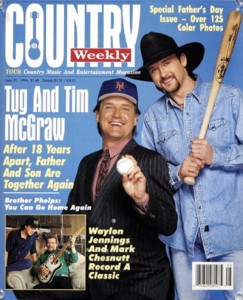Written by Abby Shamis. 9 April 2015
Tim McGraw’s latest album Sundown Heaven Town has dominated the charts with hit songs, reminiscent of how he dominated the country music charts in the 90s. One reason is that this album is a product of something McGraw had wanted to do that is different than his previous albums. This new album was intended to be more of a reflection on his life, and the song “Dust” on this album is a perfect representation of what he was trying to accomplish.
When first listening to this song, it seems to be an upbeat story about a man that lives in a drought-ridden town, causing there to be a lot of dust. It is a classic country setting, with dirt roads, beer, and a woman riding along with the man in his truck. But when peeling back the layers, the song can have another deeper meaning.
Tim McGraw had a rough adolescence. He discovered that his biological father was not the man that he had grown up thinking he was. There were lies, confusion, and a lot of pain. But in the end, a relationship with his biological father prevailed, and he became a country music tycoon with his superstar wife and three daughters.
This backstory has a direct relation to this song. In the chorus, McGraw sings:
“Dust in the rearview, dust in the cedar
Dust on the bottle, coming out of them speakers
Dust on my boots, dust on my truck
Probably got a little running in my blood…”
The dust on the rearview mirror is a reference to the troubles in his past, while the dust in his blood references how those troubles are still a part of who is he today. The dust is indicative of how secrets were covered up and how his life was not as clear-cut as he had previously thought. The dust has quite literally and figuratively covered everything that he knew, including himself.
The lyrics in this song were intended to have a certain message for its listeners. While it can be interpreted as the simple song it is portrayed as with the more traditional and older-style of the verse-chorus formation, it can also be interpreted as a way that Tim McGraw is exposing a more personal side of himself, without being totally forthcoming about it. The structure of this song follows a simple style with a pre-chorus before each chorus. This allows the listener to follow along easily to the story he is telling but then get pulled back in to the meaning of the song after each verse. The pre-chorus serves as a hook and provides a certain energy to the song that allows the listener to stray with his words and then get brought right back in to the chorus and the main message of the song.
The country-rock style to the song provides a way for McGraw to be personal about his life, while also brushing off the troubles. Listeners can relate to this in their own ways by tying it in to their own lives in whatever aspect it is relevant. This song is a showcase of the confusion that McGraw had to deal with and overcome in his life and by putting it on display in to the generalized category of dust, listeners are able to relate in a subtle way. This is a struggle Tim McGraw has had to carry around and something he had no control over. He was able to generalize the struggle he dealt with in this song so that those that had to go through something similar were able to relate.
One way that McGraw accomplishes displaying this message is the amount of times he repeats the word “dust.” Tim McGraw uses a repetitive form in order to display his message to the listeners by emphasizing that word’s importance. He sings about dust in many forms by adding a little bit of variation to it in the verses, where he explains all of the places that dust is and where it is coming from. This puts an emphasis that the dust he is singing about is a symbol since it has had such a large influence and presence in the song.
The other words that Tim McGraw uses in this song are direct, realistic, and meaningful. They produce clear images in the listener’s mind. He sings:
“Dust on the top of an old beer can
Before I take a sip I wipe it off with my hand”
This is an example of the imagery that McGraw uses in his lyrics to display clear visuals to his listeners. It produces a vivid image in the listener’s mind of being on a dirt road clearing dust off of a beer can. It also even further shows how much of his life is covered in this dust and how even though he wipes it off, the dust will physically be on him and be a part of who he is.
 Tim McGraw is no stranger to emotional songs. McGraw has sang many sad songs in his career, but in this album in particular he has said that the goal was to slow it down and reflect more about his life. While some of the songs in this album are more clearly a reflection on how important his wife, Faith Hill, is to him, this song is more of a view in to his past without being clearly stated. McGraw has a unique ability to relate to his listeners in a direct way without them always realizing how personal the message really is. This song is a perfect example of that, and one of the most personal, as well as relatable, songs that he has ever sang.
Tim McGraw is no stranger to emotional songs. McGraw has sang many sad songs in his career, but in this album in particular he has said that the goal was to slow it down and reflect more about his life. While some of the songs in this album are more clearly a reflection on how important his wife, Faith Hill, is to him, this song is more of a view in to his past without being clearly stated. McGraw has a unique ability to relate to his listeners in a direct way without them always realizing how personal the message really is. This song is a perfect example of that, and one of the most personal, as well as relatable, songs that he has ever sang.
| Time | Form | Listening Cues | Discussion |
| 0:00-0:13 | Intro | Guitar | The tune is upbeat and has a country-rock feel to it. There is a heavy influence on the guitar. |
| 0:14-0:26 | Verse 1 | “It’s rolling in the wind…” | The tempo slows a little and McGraw’s voice takes over the attention of the song. There is now more of a drum influence behind McGraw’s voice. |
| 0:27-0:39 | Pre-chorus | “Oh, drifting up and down…” | The word “oh” is drawn out and long while the rest of the pre-chorus is more spoken than sang. |
| 0:40-1:06 | Chorus | “Dust in the rearview…” | The momentum of the song builds to this point and resembles the tempo of the intro. The guitar comes back and can be heard more prominently. The last word “dust” in the chorus follows a drop in guitar with added emphasis. |
| 1:07-1:11 | Intrumental | Guitar | The guitar concludes the energy from the chorus before slowing back down in to another verse. |
| 1:12-1:24 | Verse 2 | “When the moon comes up…” | The vocals dominate over the guitar and the tempo is again slower than the chorus and introduction. The drums remain similar to how they were in the first verse. |
| 1:25-1:37 | Pre-chorus | “Oh, a couple of days without no rain…” | The “oh” is sung more drawn out and the rest of the lyrics are spoken than sang, except for the very end where he picks up the energy and increases the anticipation of the next chorus. |
| 1:38-2:07 | Chorus | “Dust in the rearview…” | The guitar picks back up and has more influence on the song. At the end of the chorus, McGraw drags out the word “dust” and an electric guitar takes over leading in to an instrumental portion of the song. |
| 2:08-2:16 | Instrumental | Electric guitar | There is an intricate guitar solo that again concludes a lot of the energy built in the pre-chorus and chorus. The drums are heard in the background. |
| 2:17-2:29 | Pre-chorus | “Oh, drifting up and down that main street drag…” | This pre-chorus is similar to the others in the momentum is sustained but there is an addition to more prominent drums as well as the electric guitar. |
| 2:30-2:57 | Chorus | “Dust in the rearview…” | This chorus more resembles the first chorus he sang. There is prominent electric guitar in the background but the word “dust” is not overly accentuated at the end this time. |
| 2:57-3:32 | Outro | Guitar | This is mainly guitar but McGraw repeats “covered up in dust” multiple times as well as some faded “oh’s” in the background. The song then fades out. |
Works Cited
Bio. A&E Television Networks, 2015. Web. 5 Mar. 2015.
Mansfield, Brian. “Tim McGraw likes glow of ‘Sundown.’” USA Today 16 Sept. 2014: n. pag. Academic Search Complete. Web. 26 Feb. 2015.


